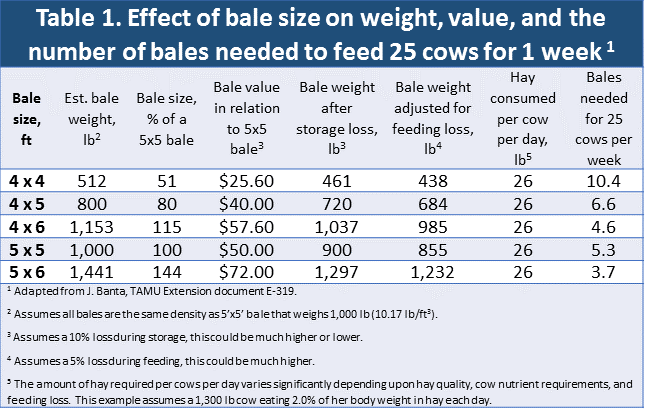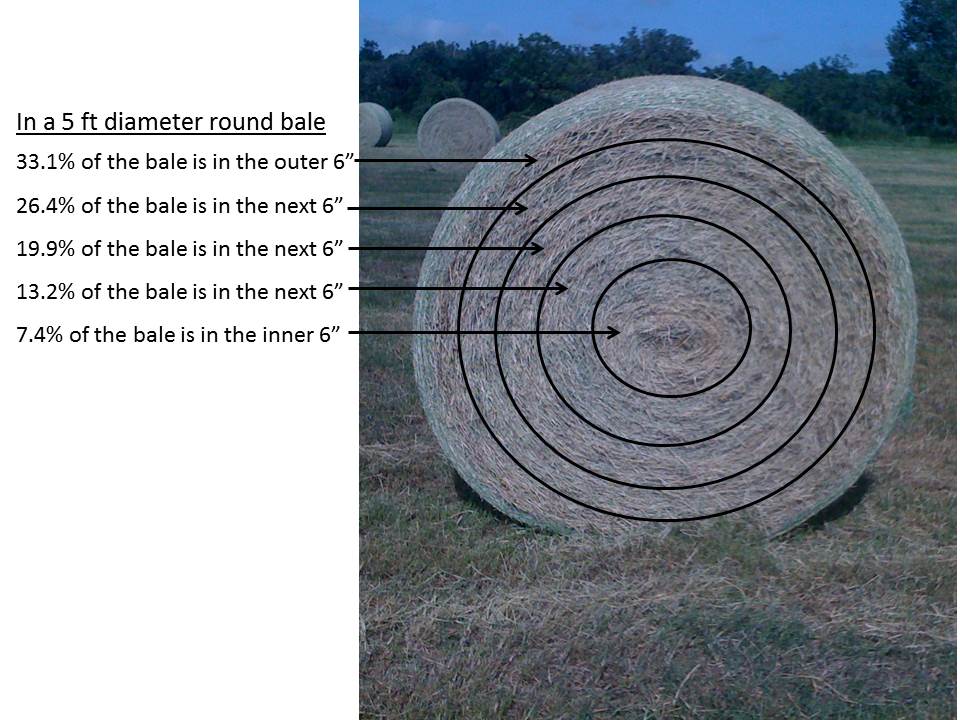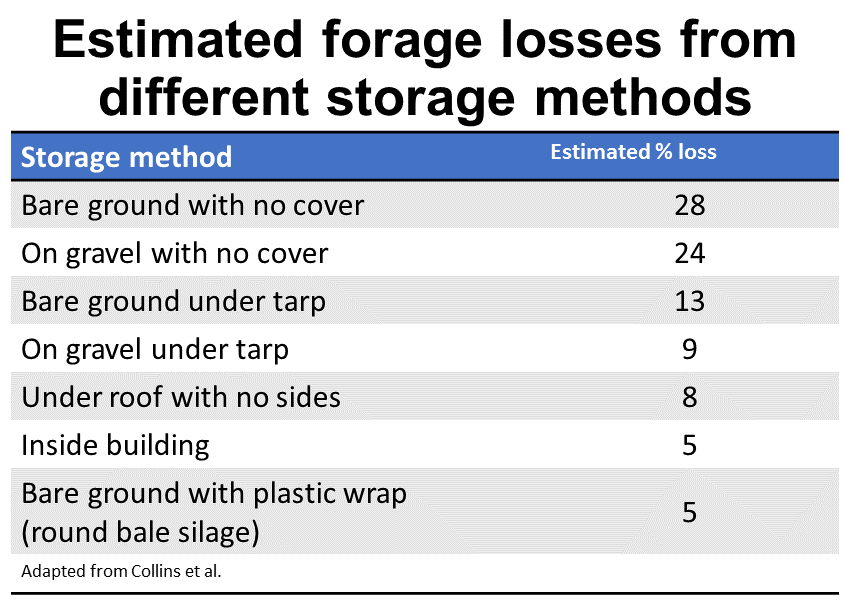Now is the time to start planning for the hay making season, so let’s consider the size issue when it comes to hay bales. In a lot of situations size really does matter, because bale size has the greatest influence on the total weight of hay in a bale, how many pounds of nutrients are in that bale, and how much hay is lost to spoilage during storage and feeding.
At issue are the large round bales which are the predominant form of hay made and fed to cattle. Large round bales can be made of many different sizes (diameter and height) which result in different total bale volumes. Bale volume is important, because when volume is combined with the bale density it results in the total weight of the bale. Table 1 demonstrates the impact that bale size has on the total bale weight when bale density is constant for all bales. If a 5×5 bale is the standard that is set, then bales with smaller dimensions have proportionally less weight and less value, and bales that have larger dimensions have proportionally more weight and greater value compared to the standard bale. In practice, cows do not consume every pound of conserved forage that goes into a large round bale. There are in fact losses associated with storing hay bales that can range from as little as 5% for bales stored inside a building or wrapped in plastic to as much as 28% for bales stored on the ground outside with no cover. Covering hay with a tarp can reduce storage losses by 15%, and a barn can reduce losses by 20% as seen in the following chart.
In practice, cows do not consume every pound of conserved forage that goes into a large round bale. There are in fact losses associated with storing hay bales that can range from as little as 5% for bales stored inside a building or wrapped in plastic to as much as 28% for bales stored on the ground outside with no cover. Covering hay with a tarp can reduce storage losses by 15%, and a barn can reduce losses by 20% as seen in the following chart.
Finally, not every pound of hay that is delivered to the cow herd is consumed, cows will waste hay. The amount of hay that is wasted by the cow depends upon many factors including: maturity, forage type, feeding method, and time of year. In Table 1 above, a 10% loss for storage is assumed, as well as a 5% feeding loss is assumed. The amount of hay that would still be available for consumption from each bale size in indicated. The numbers calculated in the table show that the amount of hay originally baled into the bale and the amount of hay the animal will consume differ greatly. Finally, if you factor in what an average cow consumes, you can estimate the number of hay bales that would be required to supply the hay needs for a 25 cow herd. Depending on the size of the bale there is a 50% difference in the number of hay bales required for the cow herd in a week. These hay needs do not consider the quality of the hay product, just the amount of hay consumed. Consider also that the more hay bales required on a weekly basis will affect the number of trips with a truck or tractor and the labor expense associated with feeding smaller bales.
The graphic below, shows the proportional amounts of hay that are contained within each of five six-inch cross-sections of a five foot diameter hay bale. Roughly 1/3 of all the hay in a large round bale is in the outer six-inch ring of the bale. Now consider where does the majority of storage and feeding loss occur from a large round bale? From the outer six inches. As bales become smaller the outer six inches of the bale becomes a greater proportion of the total bale. Therefore, as bale size shrinks the potential for increased storage and feeding loss of the hay product also increases. Not only do storage and feeding loses rob the cows of nutrients, storage and feeding losses rob your money. A bale that costs $45/ton of hay now cost $51.75 with 10% storage loss and a 5% feeding loss.

Proportion of bale contained within 5 six-inch sections of a Coastal bermudagrass large round bale. (Alachua, FL Photo credit Matt Hersom).
Finally, when purchasing hay consider buying hay on a weight basis rather than by the bale. Cows don’t have a need to consume hay by the bale, they consume pounds of hay to meet their intake requirement. Cows need to eat a defined amount of feed each day; it makes no difference to them if it comes from a small or large bale. However, small bales not priced appropriately, not stored correctly, and not managed for proper feed-out present a variety of management issues. Purchasing hay on a bale basis rather than a weight basis can permit smaller, undersized bales to eat into your pocketbook. Ultimately consider what you are creating or buying in a large round hay bale. Is there value in the product and is it everything that it needs to be.
- Clemson Virtual Southeast Cow-Calf Conference – November 11-12 - November 6, 2020
- Dispelling Cattle Mineral Supplementation Myths - November 15, 2019
- What Influences Profit for the Beef Cattle Enterprise? - June 3, 2019

